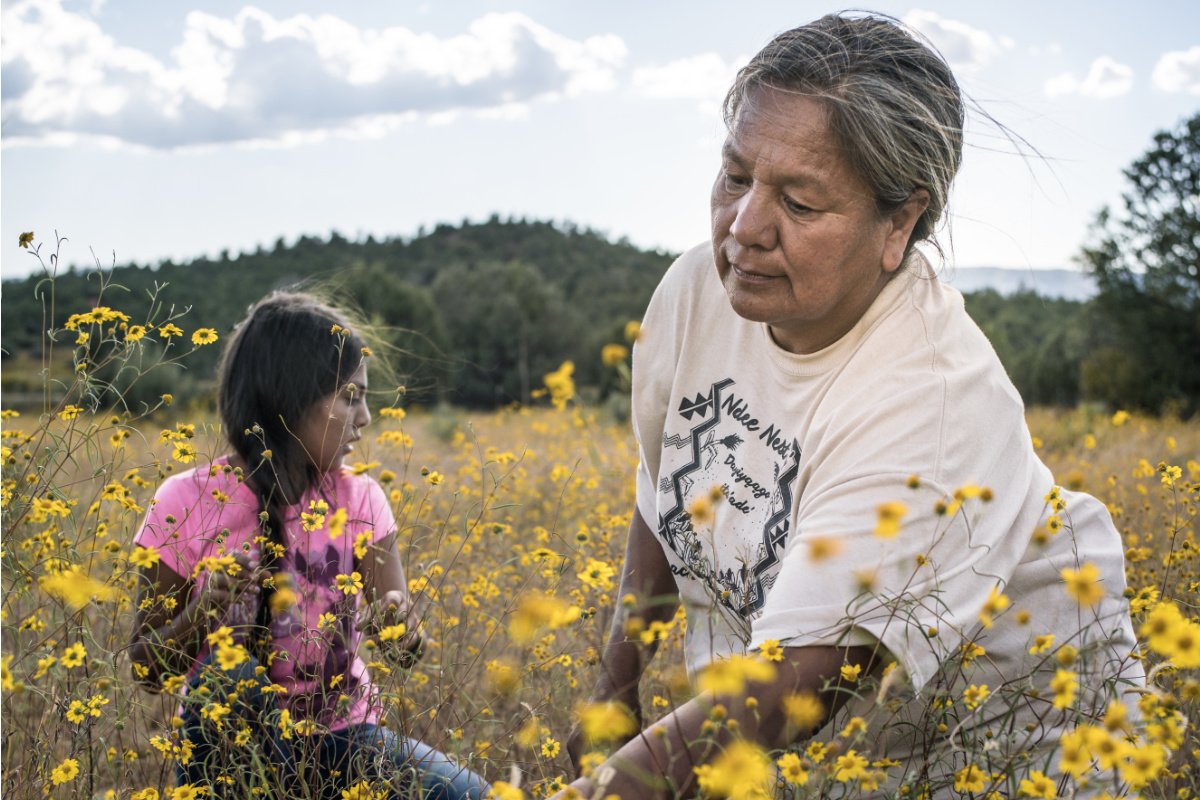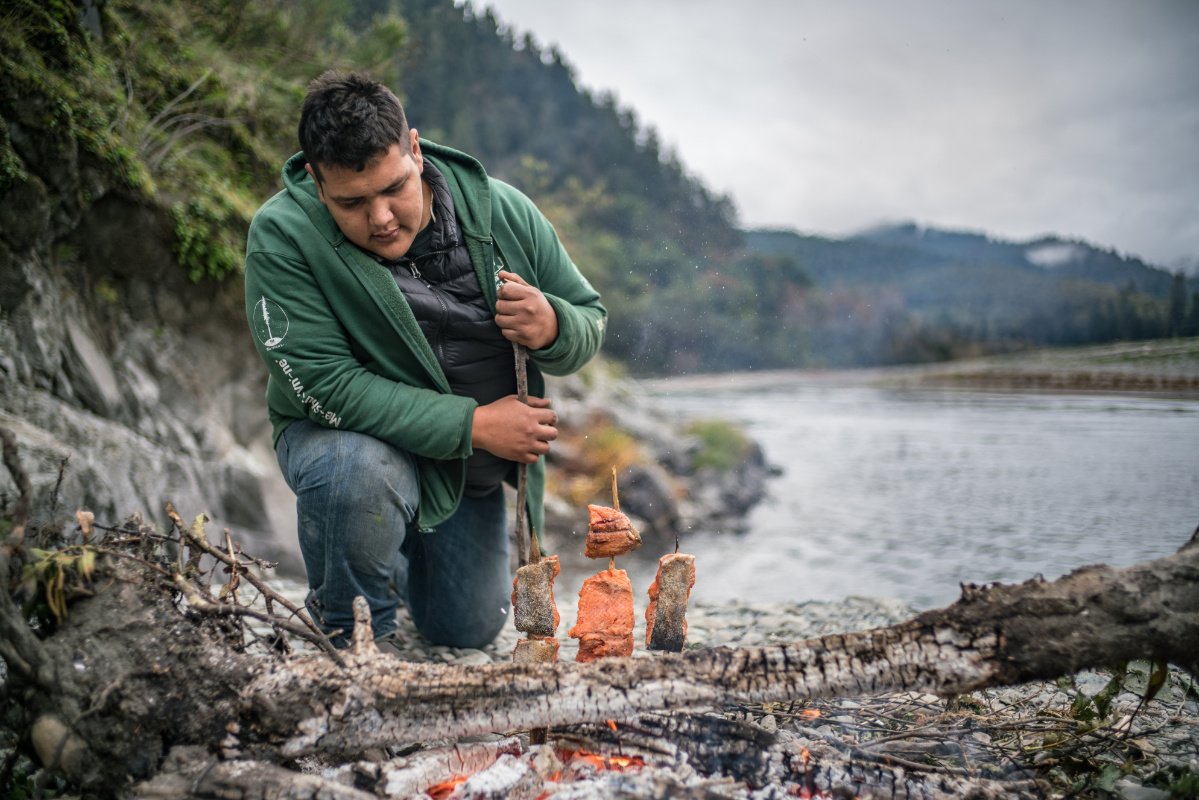For centuries, Native communities have focused on the collective rather than the individual. Here’s what we can learn from them.

For centuries, Native communities have focused on the collective rather than the individual. Here’s what we can learn from them.
March 3, 2025

Traditional forager Twila Cassadore of the San Carlos Apache Nation gathers wild amaranth seeds with her niece, as seen in the documentary Gather. (Photo credit: Renan Ozturk)
A version of this article originally appeared in The Deep Dish, our award-winning member newsletter. To get the next issue in your inbox, become a member today.
Expand your understanding of food systems as a Civil Eats member. Enjoy unlimited access to our groundbreaking reporting, engage with experts, and connect with a community of changemakers.
Already a member?
Login
In the Arctic and Far North, where a successful hunt can mean the difference between feeding the village or scrounging to make ends meet, one might assume a scarcity mindset would take hold. Instead, reciprocity prevails.
Examples of this sharing-focused approach abound. A recent documentary, One With the Whale, follows the hunting practices of an island community in the Bering Sea. In one scene, after a long period without finding game, a hunting crew harpoons a seal, which will allow them to feed some of the community. “It’s always a blessing to receive any animal that you catch,” Siberian Yupik hunter Daniel Apassingok tells the filmmakers. “As small as the game is, the game is dispersed with four or five other boats. We don’t ever say no to anybody.” Later, when the hunters take a whale, his wife, Susan, characterizes this too as a “blessing,” describing it in a way that recognizes it as beyond a commodity.
The notion of “mutual aid” is relatively new in name, but it mirrors a concept that’s been prioritized by Indigenous cultures since time immemorial: a focus on the collective. A foundational value among Native American communities, it stands in stark contrast to America’s modern hyper-fixation on the individual.
This idea of reciprocity extends far beyond humans, beginning in the natural world around us. It is a worldview informed by abundance and mutual existence—not scarcity and competition—where gratitude trumps greed. At a time of pervasive extraction and exploitation, we might take a moment to understand the importance of this worldview, still practiced the world over.
“In a traditional Anishinaabe economy, the land is the source of all goods and services, which are distributed in a kind of gift exchange: One life is given in support of another,” Potawatomi botanist and author Robin Wall Kimmerer writes in her newest book, The Serviceberry: Abundance and Reciprocity in the Natural World. “The focus is on supporting the good of the people, not only an individual. Receiving a gift from the land is coupled to attached responsibilities of sharing, respect, reciprocity, and gratitude.”
Throughout my work covering Indigenous foodways for Civil Eats and beyond, I have witnessed this culture of abundance and generosity time and again. The idea is expansive, beyond human, and happening all around us all the time—even right under our feet in the soil, where carbon, nitrogen, and phosphorus cycle in an interdependent exchange.
“In a traditional Anishinaabe economy, the land is the source of all goods and services, which are distributed in a kind of gift exchange: one life is given in support of another.”
Symbiotic relationships in the natural world are well-documented by Indigenous knowledge-keepers. Centuries ago, tribal communities across Turtle Island, as North America is commonly referred to in Native circles, began growing the three sisters—corn, beans, and squash—maximizing their complementary properties and creating a mini-ecosystem that results in higher yields and improved soil health. Each plant contributes to the well-being of the other, for the well-being of all.
Much in the same way, Indigenous groups had long stewarded the land in a collective, non-extractive manner, until European standards of private land ownership were forced upon them. To reject this extractive, “scarcity” thinking, Kimmerer reminds us, is to make way for another kind of economy: “In a gift economy, wealth is understood as having enough to share, and the practice for dealing with abundance is to give it away. In fact, status is determined not by how much one accumulates, but by how much one gives away,” she writes.
In a society driven by scarcity thinking, generosity can seem like a radical concept, but within Indigenous cultures, it’s intuitive. For instance, many tribal nations in the Pacific Northwest regularly host potlatches—the word comes from the Chinook term meaning “to give”—which are festive feasts centered on gift exchanging.
“When one’s heart is glad, he gives away gifts,” the late, visionary ‘Na̱mg̱is filmmaker Barb Cranmer explains in a short documentary series about the potlatch ceremony. “It was given to us by our creator, our way of doing things, of who we are. The potlatch was given to us as a way of expressing joy. Everyone on earth is given something. This was given to us.”
Much like this ceremony dedicated entirely to the dissemination of food and gifts, there are words in many Native languages simply meaning “to share food.” This focus on the greater good isn’t just something that happens in community, in isolation, or in the past. It’s happening today, and Indigenous thought leaders are incorporating this value of reciprocity into their business models as well.

Samuel Gensaw III of the Yurok Nation roasting wild salmon from the Klamath River, as seen in the documentary Gather. (Photo credit: Renan Ozturk)
Oglala Lakota chef Sean Sherman, for example, imparts this ancestral wisdom with his nonprofit North American Traditional Indigenous Food Systems (NĀTIFS), which promotes Indigenous foodways access and education. Back in 2020, Sherman delayed the opening of his acclaimed restaurant Owamni in order to distribute free meals after the police killing of George Floyd and the subsequent uprising that transformed entire Minneapolis neighborhoods into food deserts.
Now, Sherman is turning his attention to supplying decolonized food—meaning devoid of Eurocentric ingredients such as beef, pork, chicken, dairy, wheat flour, cane sugar, and the like—to institutions such as schools and hospitals. He is getting one step closer to realizing his vision of bringing the myriad benefits of Native foodways to people everywhere.
Then there’s Denver-based restaurant Tocabe, which donates Indigenous ingredients and ready-made meals to tribal communities across the country with every purchase made from its online marketplace. For Osage cook and co-owner Ben Jacobs, this food reciprocity is at the heart of all his work, reminiscent of the feasts his tribal nation has long held to honor elders and other community members.
These cycles of reciprocity aren’t just to show love and respect to one another; they’re also imperative for our collective future.
“In [a] climate of sufficiency, our hunger for more abates and we take only what we need, in respect for the generosity of the giver,” writes Kimmerer. “Climate catastrophe and biodiversity loss are the consequences of unrestrained taking by humans. Might cultivation of gratitude be part of the solution?”
These themes ripple through the 2020 documentary Gather, about the Native movement to reclaim cultural identity through food sovereignty. In one scene, a group of young Yurok men fish for salmon along the Klamath River, but with no luck. Seeing this, a family friend shares his catch, giving them a huge salmon, which they’ll cook over a fire alongside the rocky riverbank later that night. “He’s helping us out because it’s important,” one of the youths says as he carries the massive fish back to camp. “And that’s how we do it.”

July 30, 2025
From Oklahoma to D.C., a food activist works to ensure that communities can protect their food systems and their future.
Check out my paper, The Origins of Political Behavior, and the First Political System. Let me know what you think of it.